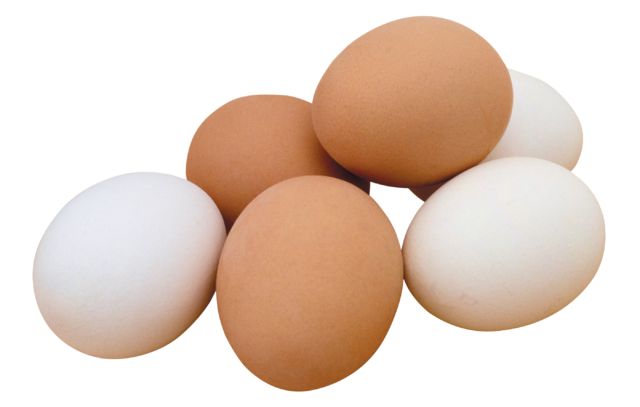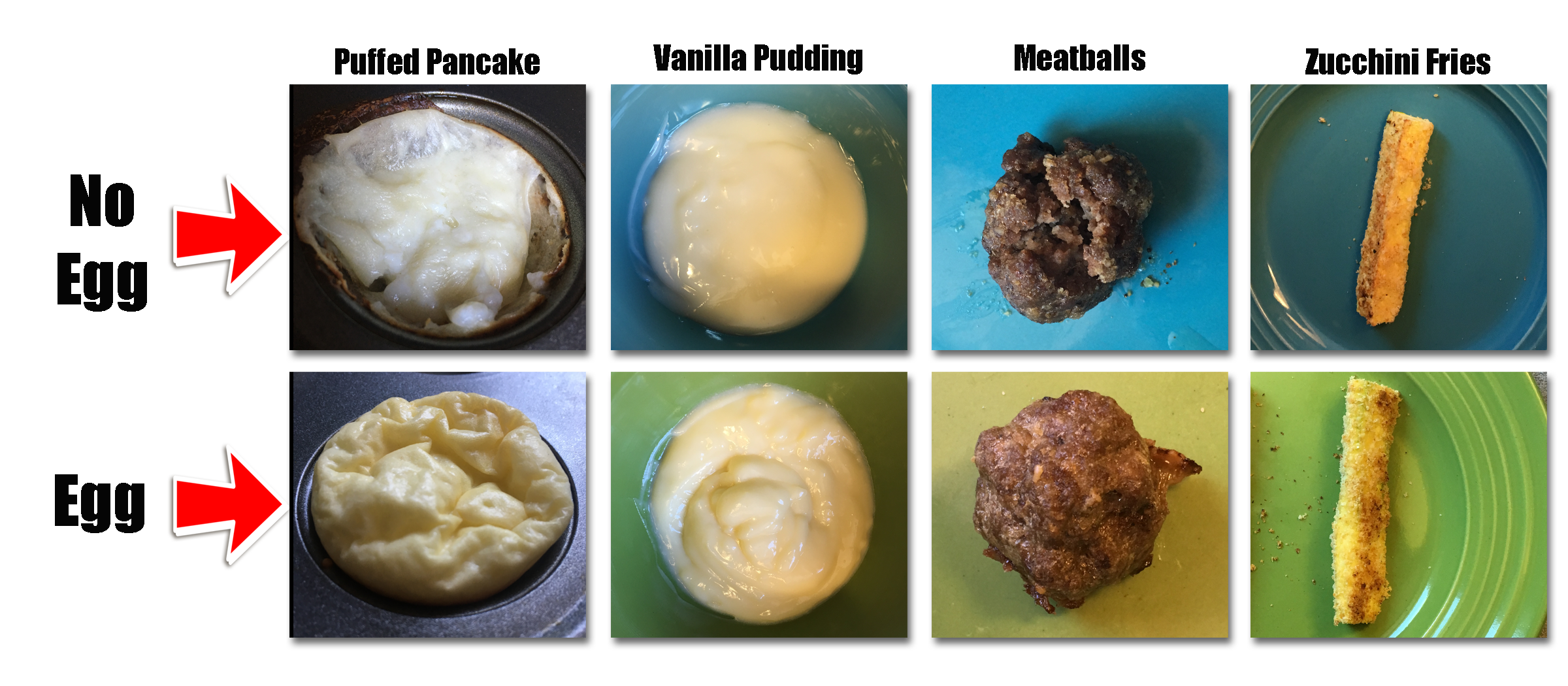Agricultural Literacy Curriculum Matrix
Lesson Plan
Don't Forget the Eggs!
Grade Level
Purpose
Students will discover the five culinary functions of eggs by completing a cooking lab comparing recipes with and without eggs. Students will see how eggs leaven, bind, thicken, coat, and emulsify our foods. Grades 9-12
Estimated Time
Materials Needed
- Ingredients and equipment for cooking labs, see individual recipes
- Functions of Eggs lab packet, one or two classroom copies
- The Incredible Egg worksheet, 1 per student
- The Incredible Egg worksheet KEY
- Function of Eggs PowerPoint slides
Vocabulary
emulsify: the ability to combine liquid and fats into one cohesive mixture without separating
leaven: increase volume and create lightness in food products
nutrient dense: foods that are high in nutrients but relatively low in calories
Did You Know?
- An egg shell has approximately 17,000 pores on its surface.1
- Eggs contain high-quality protein with all nine essential amino acids. Dietary protein helps support muscle health in active people of all ages.2
- The US produces about 95.3 billion eggs per year.3
Background Agricultural Connections
While all species of birds and many species of reptiles lay eggs, the chicken egg is the most commonly consumed egg in the United States. Chicken eggs are the egg of choice because chickens are the most efficient to raise on farms for the production of eggs. A mature chicken hen can lay over 300 eggs per year.
Eggs are a nutrient dense food and contain only 70 calories and 6 grams of high-quality protein per large egg. An egg is made up of two main parts. The yolk contains fat and other nutrients. The egg white is made mostly of water and protein. Eggs also contain other important nutrients such as iron, calcium, vitamin D, vitamin A, choline and the carotenoids lutein and zeaxanthin.
Eggs can be prepared many ways and are important ingredients in cooking and baking. Eggs can be hard cooked, soft cooked, scrambled, fried, and poached. Eggs are also crucial to many cooking and baking recipes. Eggs go through a chemical change as they are cooked. If cooked at too high of a temperature or if they are exposed to heat for too long, the proteins will become tough. Cooking and storing eggs is important to keep them from growing bacteria that could lead to food-borne illness. Eggs should be kept in their original container and in the refrigerator.
In cooking and baking there are five main functions of an egg. They bind, thicken, coat, serve as a leavening agent, and emulsify. Egg whites can be whipped to create an egg white foam. The foam is filled with air which helps to leaven baked goods. Egg yolk prevents egg whites from foaming, so it’s important to separate egg whites and yolks with care. Egg whites help keep baked goods moist without changing the flavor of foods. The egg yolk has a high percentage of fat as well as protein and water. If a recipe calls for an egg yolk, it is typically for the high fat content, increasing the ability to emulsify. Yolks also have the ability to thicken mixtures when they are heated because the proteins begin to denature and gel. Egg yolks add richness, flavor, and color to baked goods.
Engage
- Ask students what they know about eggs. Inform them that you are going to test their knowledge about eggs. They will need to identify the following statements4 as true or false.
- You can tell if an egg is raw or hard cooked by spinning it on a flat surface and observing how it spins.
- True: Hard cooked eggs spin easily and stop. If the egg is raw it will wobble and continue to spin after you stop it.
- The average hen lays 100-150 eggs a year.
- False: Hens on average lay 250 to 300 eggs a year.
- The older a hen is, the smaller her eggs are.
- False: The opposite happens, hens lay bigger eggs as they age.
- Egg yolks contain vitamin D naturally.
- True: They are one of the few foods that naturally contain vitamin D (without fortification).
- Egg yolks are always light orange in color.
- False: The color of the yolk depends on the diet of the hen.
- Eggs should be stored in the refrigerator.
- True: It's best to place your eggs on an inside shelf in the fridge. An egg carton helps keep the eggs from picking up odors and flavors from other foods and helps prevent moisture loss.
- The fastest omelet maker in the world made 427 two-egg omelets in 30 minutes.
- True: Howard Helmer is the Omelet King and holds three Guinness World Records for omelet making.

- True: Howard Helmer is the Omelet King and holds three Guinness World Records for omelet making.
- You can tell if an egg is raw or hard cooked by spinning it on a flat surface and observing how it spins.
Explore and Explain
- Ask students to think of some recipes they are familiar with and help you brainstorm common cooking ingredients. (flour, sugar, milk, eggs, oil, water, etc.) Ask students if they have ever forgotten an ingredient when they were baking. Ask how they could tell the ingredient was missing, and allow students to share their experiences.
- Summarize the discussion by recognizing that every ingredient plays a specific role in a recipe.
- Divide the class into small groups. Give each group one recipe from the Functions of Eggs lab packet. For a large class, divide into eight groups, assigning two groups per recipe. For a smaller class, divide students into four groups, assigning each recipe to one group.
- Provide lab supplies, cooking ingredients, and instructions as needed for students to make their recipes. Instruct students to follow the directions on the recipe exactly. Let them know that they will be purposely leaving out the egg in a small portion of their recipe to determine the function of the egg in their recipe.
- After students have completed their recipe, bring the class back together. Each group will show their final products, with and without egg. Have each group describe the differences to the class, and then hypothesize the function of the egg in their recipe.

- Give each student one copy of The Incredible Egg worksheet.
- Explain that science plays a part in the cooking process and can explain the outcome of the recipes with and without egg.
- Show a series of videos and provide accompanying explanations for students to complete the front page of their worksheet. Project The Incredible Egg worksheet KEY and/or use the KEY as an outline for your discussion while students take notes as you speak. Let students know that they can leave the "example" section blank until the review at the end of class. The Egg Functionality Videos can be found on the Incredible Egg YouTube channel.
- Leavening- Watch How do Eggs Form a Foam? Explain that the egg white helps trap air allowing the baked good to rise and be light and fluffy. (i.e.: popovers)
- Binder- Egg proteins coagulate and help bond the structure together. This enables the food to stick together and not fall apart. (i.e.: meatballs)
- Thickener- Watch How do Eggs Assist with Gelation? Explain that egg proteins denature. They form a gel which thickens the food. (i.e.: vanilla pudding)
- Coating- Since the egg white and yolk are thicker than water and other liquids, egg helps flour, seasonings, or breadcrumbs stick to food. (i.e.: zucchini fries)
- Emulsifier- Watch How do Eggs form a Stable Emulsion? The proteins in an egg yolk help form a stable product by not allowing the water and oil to separate. (i.e.: mayonnaise) Clarify that you did not make an example of an emulsion in the lab. As an alternative, show the Advanced Cooking - Mayonnaise video with Chef Robert to illustrate the role of eggs in mayonnaise.
- Explain to students that eggs have many great qualities. In addition to their five different functions inside a recipe, we can also eat eggs cooked in various ways.
- Have students complete the back of their worksheet. Project the teacher key on the board as you discuss answers to the questions.
Elaborate
-
Watch Howard Helmer, a famous American chef make an omelet. He holds the Guinness World Record for being the fastest omelet maker.
-
Hold an omelet making contest in class.
-
Explore more egg videos from the Incredible Egg YouTube channel.
-
Do an emulsion demonstration in class using instructions from the I Second that Emulsion lab from The Science Behind Our Food program.
-
To learn more about different types of egg farms and corresponding labels (cage-free, free range, etc.) see, Weighing in on Egg Labels, Supply and Demand.
Evaluate
- Project the Function of Eggs PowerPoint. Discuss the recipe and picture on each slide. Have students identify the purpose of the egg(s) in each of the recipes.
- Teacher Tip: The correct answer can be found in the "notes" section of each PowerPoint slide. As students come to a conclusion for each recipe, have them write the recipe title in the "example" section of The Incredible Egg worksheet.
- At the conclusion of these activities, review and summarize the following key concepts:
- The eggs we eat are most likely produced by chickens. Eggs are nutrient dense and can be part of a healthy diet.
- Eggs can be prepared in many ways including hard cooked, soft cooked, scrambled, fried, and poached.
- Eggs are an important ingredient in many cooking recipes to leaven, bind, thicken, coat, or emulsify the ingredients in a recipe.
Sources
- https://www.incredibleegg.org/wp-content/uploads/2020/07/BeaDetEGGtive.pdf
- https://www.incredibleegg.org/wp-content/uploads/2020/07/ENC-Protein-2019-Web-1.pdf
- https://www.incredibleegg.org/about-us/industry-data
- https://www.incredibleegg.org/
Recommended Companion Resources
Author
Organization
| We welcome your feedback! If you have a question about this lesson or would like to report a broken link, please send us an email at matrixelearning@gmail.com. If you have used this lesson and are willing to share your experience, we will provide you with a coupon code for 10% off your next purchase at AgClassroomStore. |
